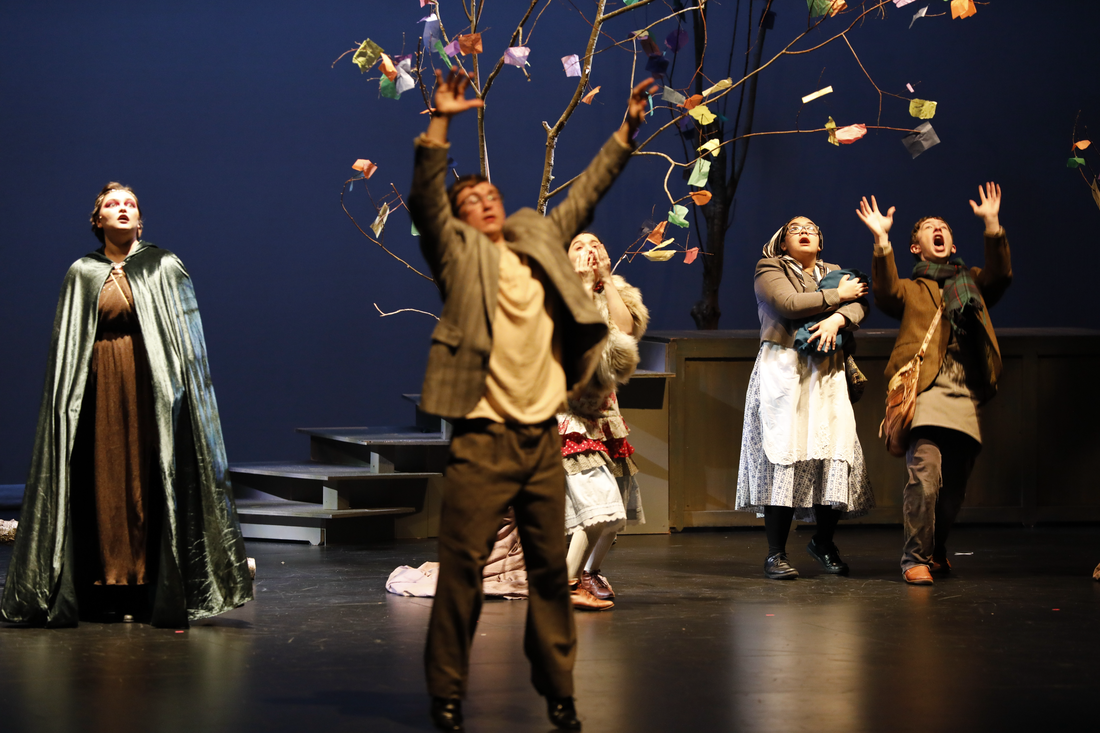|
Creating Authentic Characters (while dressed in audition clothing)
by Elizabeth McMurray-Hauk You are sitting in a darkened theatre, your eyes focused on the scene playing in front of you. A loud crack of thunder echoes, and rain pours down soaking the shed roof, the willow tree, the old bench where a young couple sit at a distance from each other - tense, silent. The lights go down. It’s intermission. You leave the theatre and head out to the lobby listening to those around you intently discussing the play. ‘I want to just hug him’, ‘She has a secret reason for being there’, ‘He needs help’, ‘She knows something’. No one is talking about the playwright’s brilliant dialogue, the director’s thoughtful interpretation, the designer’s provocative artistry, or the actor’s ability to create a character. They are reacting to the scene as if it is actually happening, as if the two people on the bench really exist. That is what you want an audience to be doing, to sink into the world of the play, to experience the truth in that world. As an actor you need to be clearly heard, you need to use your body in dynamic and specific ways, you need to understand why the character you are portraying reacts the way they do. This is acting technique. It takes years of hard study to successfully do the work of an actor: to create believable characters. Ironically, though, you can be an excellent presentational performer and still have less-then-believable characters. There is a trick to creating an authentic character, a critical ingredient that must be present for a character to be real. A way to truly make those people on the bench exist. Place your characters in their personal world. Place your characters in their authentic world. Understand what that world is, and you will know why the character moves, talks, acts, and feels the way they do. You will create a believable character, and bring your audience into their world. What is the world of the character? You can begin to figure that out by knowing the time and place they live in, but those are superficial constraints. They must be present, but they aren’t the key. The key is the individual character’s world within the larger world of the play. Think of it this way: everyone in your family is in the same time and place (your home, present day). But where do YOU fit in to that world? How is it different from other members of your family? How is the world uniquely yours? Your characters exist within their world in the same individual way you exist in yours. It’s your job as an actor to become another person, not a stereo-type, superficial presentation of a person, but a unique, complete person. In many ways an ordinary person in an extraordinary moment. The only way to do that is to think like your character, to be completely present in their personal world. The words that come out of your character’s brain are the end-product of a whole lot of thinking that has already occurred! The words themselves are not nearly as important as how your character arrived at that moment to say what they are saying, and that is the direct connection to their distinct, individual, one-of-a-kind, world. As you work on creating characters for an audition explore the authenticity of the world where each character exists, their reason for arriving at this particular moment. That motivation comes from within, so look deeply into their thought process. As an actor you will be in an audition hall, wearing your audition clothing, without a set or lights or props or sound to create the world of the play. But the character you are playing will not need an externalized world – your character’s world is carried inside their heart, their mind, their experiences. It is expected for you to memorize and speak your lines at the right time and with the right expression; it is necessary to have your character need to say those words because at this moment in their world only those words make sense. Place your character in their own personal world and you will leave your audience believing that your character is real. ps: The ‘Other’ (while dressed in rehearsal clothing) by Elizabeth McMurray-Hauk A real person is never alone, even when no one else is in the room with them. All monologues and soliloquies, sung or spoken, have the ‘other’. Sometimes that person is literally present in the scene, sometimes they are not, but the character is always aware of them and addresses their thoughts with the ‘other’ in mind. You can’t be believable without the ‘other’. How we create a relationship on stage is as unique as the relationships we have in our own personal lives. Real life is different from the life of characters in a play, though, because stage moments are compressed life moments. We don’t go to the theatre to watch people trudge through their normal daily routines. We go to watch something big happen to them. When something big happens to you, you either tell someone or go off and think about it with someone in mind. You have a personal rant. You have a deep need for someone to understand. That someone is your ‘other’. In an audition setting the actor is alone. But the character is not. The ‘other’ must be present. This is as obvious and as complex as developing the personal world of the character; the ‘other’ is a necessary part of that world. Your character would not be in that moment saying what they are saying without the ‘other’. Assignment: With your rehearsal partner explore your performance pieces, identifying and working with the ‘other’. How does your audition partner help you with the ‘other’?
“Acting is behaving truthfully under imaginary circumstances.” Sanford Meisner |



